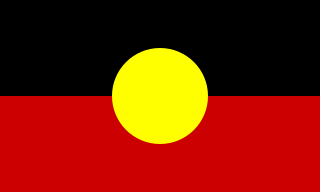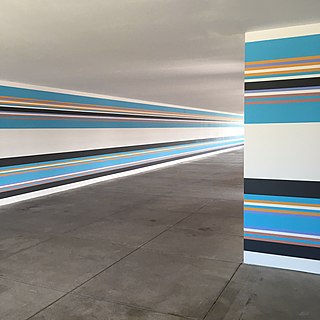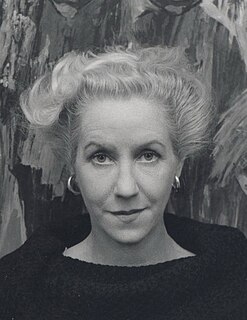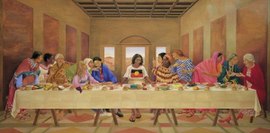
The Last Supper is a mural painting by the Italian High Renaissance artist Leonardo da Vinci, dated to c. 1495–1498. The painting represents the scene of the Last Supper of Jesus with the Twelve Apostles, as it is told in the Gospel of John – specifically the moment after Jesus announces that one of his apostles will betray him. Its handling of space, mastery of perspective, treatment of motion and complex display of human emotion has made it one of the Western world's most recognizable paintings and among Leonardo's most celebrated works. Some commentators consider it pivotal in inaugurating the transition into what is now termed the High Renaissance.

The Australian Aboriginal Flag represents Aboriginal Australians. It is one of the officially proclaimed flags of Australia, by which it has special legal and political status together with the national flag and the Torres Strait Islander Flag, with which it is often flown.

Ginevra de' Benci is a portrait painting by Leonardo da Vinci of the 15th-century Florentine aristocrat Ginevra de' Benci. Exhibited at the National Gallery of Art in Washington, D.C., it is the only painting by Leonardo on public view in the Americas.

Emily Kame Kngwarreye was an Aboriginal Australian artist from the Utopia community in the Northern Territory. She is one of the most prominent and successful artists in the history of Australian art.
Lillian F. Schwartz is an American artist considered a pioneer of computer-mediated art and one of the first artists notable for basing almost her entire oeuvre on computational media. Many of her ground-breaking projects were done in the 1960s and 1970s, well before the desktop computer revolution made computer hardware and software widely available to artists.

Nancy Graves was an American sculptor, painter, printmaker, and sometime-filmmaker known for her focus on natural phenomena like camels or maps of the Moon. Her works are included in many public collections, including those of the National Gallery of Art, the Brooklyn Museum of Art, the Smithsonian American Art Museum, the National Gallery of Australia (Canberra), the Des Moines Art Center, Walker Art Center (Minneapolis), and the Museum of Fine Arts. When Graves was just 29, she was given a solo exhibition at the Whitney Museum of American Art. At the time she was the youngest artist, and fifth woman to achieve this honor.

Leonardo da Vinci was an Italian Renaissance painter and polymath who achieved legendary fame and iconic status within his own lifetime. His renown primarily rests upon his brilliant achievements as a painter, the Mona Lisa and The Last Supper, being two of the most famous artworks ever created, but also upon his diverse skills as a scientist and inventor. He became so highly valued during his lifetime that the King of France bore him home like a trophy of war, supported him in his old age and, according to legend, cradled his head as he died.

Although women artists have been involved in the making of art throughout history, their work, when compared to that of their male counterparts, has been often obfuscated, overlooked and undervalued. The Western canon has historically valued men's work over women's. Many of women's works have also been wrongly attributed to men artists. The widespread recognition of the work of the female artists has accelerated as they continue to produce works that complicate and challenge ones' understandings. Prevailing stereotypes about the sexes have caused certain media, such as textile or fiber arts, to be primarily associated with women, despite having once been categories, such as ceramic art, in which both men and women participated. Additionally, art forms that have gained this distinction are, as in the case of both textile and fabric arts, demoted to categories like "arts and crafts", rather than fine art.

Elizabeth Durack Clancy CMG, OBE was a Western Australian artist and writer.
Papunya Tula, registered as Papunya Tula Artists Pty Ltd, is an artist cooperative formed in 1972 in Papunya, Northern Territory, owned and operated by Aboriginal people from the Western Desert of Australia. The group is known for its innovative work with the Western Desert Art Movement, popularly referred to as "dot painting". Credited with bringing contemporary Aboriginal art to world attention, its artists inspired many other Australian Aboriginal artists and styles.

The 16th-century portrait Mona Lisa, or La Gioconda, painted in oil on a poplar panel by Leonardo da Vinci, has been the subject of a considerable deal of speculation.
Susan Dorothea White is an Australian artist and author. She is a narrative artist and her work concerns the natural world and human situation, increasingly incorporating satire and irony to convey her concern for human rights and equality. She is the author of Draw Like da Vinci (2006).

Makinti Napanangka was a Pintupi-speaking Indigenous Australian artist from Australia's Western Desert region. She was referred to posthumously as Kumentje. The term Kumentje was used instead of her personal name as it is customary among many indigenous communities not to refer to deceased people by their original given names for some time after their deaths. She lived in the communities of Haasts Bluff, Papunya, and later at Kintore, about 50 kilometres (31 mi) north-east of the Lake MacDonald region where she was born, on the border of the Northern Territory and Western Australia.

Bronwyn Bancroft is an Australian artist, and amongst the first Australian fashion designers invited to show her work in Paris. Born in Tenterfield, New South Wales, and trained in Canberra and Sydney, Bancroft worked as a fashion designer, and is an artist, illustrator, and arts administrator.

The Last Supper (1630–1631) is an oil painting by Peter Paul Rubens. It was commissioned by Catherine Lescuyer as a commemorative piece for her father. Rubens created it as part of an altarpiece in the Church of St. Rombout (Rumbold) in Mechelen. The painting depicts Jesus and the Apostles during the Last Supper, with Judas dressed in blue turning back towards the viewer and away from the table. Other than Jesus, the most prominent figure is Judas. Judas holds his right hand to his mouth with his eyes avoiding direct contact with the other figures in the painting creating a nervous expression. Jesus is dressed in red and has a yellow halo surrounding his head with his face tilted upwards. Jesus is located centrally in the painting surrounded by his disciples with six on each side, and he holds a loaf of bread with a cup of wine in front of him. Out of all of the figures, he is the most in the light with the figures to the farthest left being the most in shadow. “The scene thus represents a perfect conflation of the theological significance of the Last Supper” meaning the conflation between the blessing of the bread and the wine while still being pivotal in the sense of revealing the betrayal.

Portrait of Dorothea Berck is a 1644 painting by Frans Hals that is in the collection of the Baltimore Museum of Art. It depicts Dorothea Berck at age 51, the wife of the prosperous Haarlem merchant Joseph Coymans, whose portrait Hals also painted. Both paintings were executed on the occasion of their daughter Isabella's wedding, whose marriage pendants Hals also painted.

Shamsia Hassani is an Afghan graffiti artist, a fine arts lecturer, and the associate professor of Drawing and Anatomy Drawing at the Kabul University. She has popularized "street art" in the streets of Kabul and has exhibited her art in several countries including India, Iran, Germany, United States of America, Switzerland, Vietnam, Norway, Denmark, Turkey, Italy, Canada, and in diplomatic missions in Kabul. Hassani paints graffiti in Kabul to bring awareness to the war years. In 2014, Hassani was named one of FP's top 100 global thinkers.
Dolly Nampijinpa Daniels (1936–2004) was an Australian Aboriginal ritual leader, Warlipiri speaker, renowned artist, and land -rights advocate for the Warlipiri people of the Northern Territory.
Eileen Yaritja Stevens was an Aboriginal artist from central Australia. Although she had brief career of less than four years, she quickly became one of the most successful artists of her generation to paint in the style of the Western Desert. Her work is now held in several major public art collections across Australia.
Susan Norrie is an Australian artist working primarily with found film and original video installations to explore political and environmental issues. In 2007 she represented Australia at the 52nd Venice Biennale.














